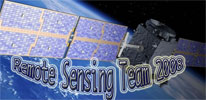
http://nia.ecsu.edu/ur/0708/teams/pg/new/index.htm
During the past 2007 Fall and 2008 Spring semesters I completed a research project on the Polycom teleconferencing system. On the Polar Grid Team my mentor was Jeaime Powell. The title of our paper was, " Implementation of a Polycom VSX 8000 Teleconferencing System: Developing Standards and Practices for
Participating in Virtual Conferences".
Our abstract reads as follows:
"One of the major goals of the Polar Grid project was to interconnect partner institutions through a virtual conferencing solution. Included in that grant were funds to upgrade the capabilities of Elizabeth City State University and partner ADMI institutions. In the case of Elizabeth City a Polycom 8000 system and VBrick video forwarding system were purchased. ADMI partner institutions received Polycom PVX kits, which could be utilized on Windows-based desktop computers.
The purpose of the Polar Grid team was to design polices that guide the usage of the polycom system to allow effective use. The policies focused on four core areas. The areas were, hosting a virtual conference, connecting to a conference, connecting ADMI partner institutions using PVX kits, and working with faculty to create a procedure to request teleconferences."

http://nia.ecsu.edu/ureomps2008/team-remote/teamwebpage.html
In the summer of 2008 I participated on the Remote Sensing Team. My mentor was Mr. Ernst Wilson. I completed a research project on the modeling of beach erosion using video imaging. The title of the IEEE formatted paper was, "The Modeling of Beach Erosion and Shoreline Changes Supported by Prior Research Based on Video Image Processing in Duck, North Carolina".
Our abstract reads as follows: "Climate change has affected the North Carolina coastal enviroments and coastal hazards have already taken place in the area. Significant adverse impacts in the form of frequent storms and higher rates of beach erosion have been registered, thus, making compelling the necessity of a current understanding of the vulnerability of coastal zones. We propose to study this vulnerability in Duck, North Carolina (location: Lat 36 10 57" N Long 75 45 05" W) utilizing the work of the Army Corps of Engineers at Duck, North Carolina at the Field Research Facility (FRF). Our interest in their work lies on the use of video imagery based techniques (researched, designed, experimented and developed by the Coastal Imaging Lab of Oregon State University) implimented for the capture and understanding of changes of near shore morphology since beaches are continuoulsy changing from geological materials (sands, dead and/or bleached corals...etc) shifted by waves, tides, and currents moving sediments and eroding shorelines; this phenomenon carries very challenging, above all devastating outcomes on coastal communities. We are most interested in the intolerant and dramatic periods of storms and hurricanes (when sediment transport is more energetic [Stockdon and Holman, 2000] and shoreline changes are more rapid) associated with extended could cover when satellite fails to produce images of events occurring during those times."

http://nia.ecsu.edu/ur/0809/teams/pg/abstract.html
During the Fall semester of 2008 and the Spring semester of 2009 I will be working on the Polar Grid Team. We are going to be installing a 64 node cluster in a newly renovated Wilkins Center on the campus of Elizabeth City State University. This project will be uder the direction of Je'aime Powell who is my mentor. Our abstract reads as follows:
"The 2008 – 2009 Polar Grid team will focus on two main areas related to grid computing. These two areas are the installation of a 64-node cluster into a raw server environment, and the installation of a permanent testing cluster.
The installation of the 64-node cluster will focus on the logistics of preparing araw office environment for a large computing cluster. The topics covered will include thermal issues, electrical issues, and security issues.
The permanent installation of a Condor-based cluster will primarily focus on the logistics of installing equipment and software in a Sun Microsystems environment. Network, electrical, procedural, and security issues will be the primary focus of the implementation. The Sun machines targeted will be a SunFire V480 management server and several SunBlade 150 workstations as workers. "
During the Summer of 2009 I participated in an Internship in Lawerence, KS at the University of Kansas. The title of the research conducted was Automatic Ice Thickness Estimation from Polar Subsurface Radar Imagery. The abstract reads as follows:
"This work focuses on automating the tedious task of estimating ice thickness from airborne radar data acquired over Greenland and Antarctica. This process involves the identification and accurate selection of the ice sheet's surface location and interface between the ice sheet and underlying bedrock for each measurement. Knowing the surface and bedrock locations in the radar imagery allows us to compute ice sheet thickness, which is very important for the study of ice sheets, their volume, and how they may contribute to climate change issues. The previous time-consuming manual approach required sparse hand-selection of surface and bedrock interfaces by several human experts, and interpolating between selections to save time. Two primary methods have been studied: edge-based, and active contour. Results are compared and presented in terms of time requirements, error, and advantages which each method offers. Automatic ice thickness estimation results from 2006 and 2007 Greenland field campaigns show that the edge-based approach offers faster processing (seconds compared to minutes), but suffers from a lack of continuity and smoothness aspects that active contours provide. The active contour approach is more accurate when compared to ground truth selections from human experts, and has proven to be more robust to image artifacts."
|
|

|
| http://www.eos.unh.edu/ResearchAndDiscover/interns_10_11.shtml#michael |
During the past Summer of 2010 i participated in the Research and Discover Program at the University of New Hampshire. This program included a two part internship. During the summer i just completed I investigated the ice flow changes of two Greenland outlet glaciers. My abstract reads as follows:
Using satellite imagery the activities of two Greenland outlet glaciers was investigated. Kangiata Nunata Sermia(KNS) located at Latitude(62.4), Longitude(-49.6) and Nunatakavsaup Sermia(NKS) located Latitude(74.6) ,Longitude( -56.0) were the sources of high variations in ice velocity changes between the years of 2001 to 2010. The changes in the ice velocities were investigated using a program written in MATLAB that tracked the most prevalent features in the ice. NKS which was the northernmost glacier was the source for the highest ice velocities through the years of 2002 and 2005. This change was primarily due to a large ice front retreat which directly affected the ice velocities throughout the years investigated. Through the years of 2002 to 2005 there was an increase in velocity of this glacier by 5 meters per year which is 1,875 meters per year. KNS showed a slight variation in velocity but this change was not a significant amount throughout the years that the data was available. As more glaciers accelerate, due to an inequality in the mass balance of these glaciers, the contribution of Greenland to sea-level rise will continue to increase. |
| |
| |
| |